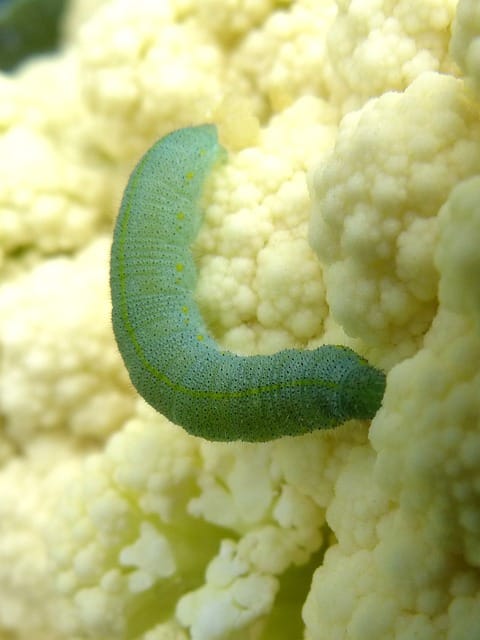Fighting gardening diseases: Cabbage loopers
Cabbage loopers, scientifically known as Trichoplusia ni, are common garden pests that can cause significant damage to cabbage and other cruciferous vegetables

In this article:
- Introduction: Understanding the Threat of Cabbage Loopers
- Identifying Cabbage Loopers: Appearance and Behavior
- The Life Cycle of Cabbage Loopers
- Common Sign of Infestation: Damage Caused by Cabbage Loopers
- Environmental Factors Favoring Cabbage Looper Infestation
- Preventing Cabbage Looper Infestation in the Garden
- Natural and Biological Control Methods for Cabbage Loopers
- Chemical Control Options: Pesticides for Cabbage Looper Management
- Organic Gardening Techniques to Combat Cabbage Loopers
- Companion Planting to Deter Cabbage Loopers
- Removing and Destroying Infested Plants: Quarantine and Eradication Methods
- Controlling Cabbage Loopers in Different Garden Settings: Container Gardens, Raised Beds, etc.
- The Role of Crop Rotation in Preventing Cabbage Looper Infestation
- Monitoring and Early Detection: Spotting Cabbage Loopers in the Garden
- Dealing with Cabbage Loopers: Mechanical Control and Manual Removal
- Conclusion: Promoting Healthy Gardens by Combating Cabbage Loopers
Introduction: Understanding the Threat of Cabbage Loopers
Cabbage loopers, scientifically known as Trichoplusia ni, are common garden pests that can cause significant damage to cabbage and other cruciferous vegetables. Understanding their behavior, life cycle, and effective control methods is essential for maintaining a healthy garden.
Identifying Cabbage Loopers: Appearance and Behavior
Cabbage loopers are green caterpillars with a distinct looping movement when they crawl. They have white stripes running along their bodies, making them easily identifiable. Their behavior includes feeding on the leaves of plants, leaving visible damage behind.
The Life Cycle of Cabbage Loopers
Cabbage loopers undergo complete metamorphosis, which means they have four stages in their life cycle: egg, larva (caterpillar), pupa, and adult. Understanding their life cycle helps determine the most effective control strategies.
Common Sign of Infestation: Damage Caused by Cabbage Loopers
The presence of chewed leaves, irregular holes, and skeletonized foliage are common signs of cabbage looper infestation. Prompt identification and intervention are crucial to prevent further damage.
Environmental Factors Favoring Cabbage Looper Infestation
Cabbage loopers thrive in warm and humid environments. Understanding the environmental conditions that favor their growth and reproduction can help gardeners take preventive measures.
Preventing Cabbage Looper Infestation in the Garden
Implementing preventive measures such as crop rotation, maintaining clean garden beds, and using row covers can effectively reduce the risk of cabbage looper infestation.
Natural and Biological Control Methods for Cabbage Loopers
Encouraging natural predators like birds, beneficial insects, and using biological control agents such as Bacillus thuringiensis (Bt) can be highly effective in managing cabbage looper populations without harming the environment.
Chemical Control Options: Pesticides for Cabbage Looper Management
In severe infestations, chemical control options may be necessary. Choosing appropriate pesticides and following instructions carefully are essential to minimize environmental impact and protect beneficial insects.
Organic Gardening Techniques to Combat Cabbage Loopers
Organic gardening techniques such as handpicking, applying homemade organic sprays, and using natural repellents can provide effective control of cabbage loopers while adhering to organic gardening principles.
Companion Planting to Deter Cabbage Loopers
Strategic companion planting by incorporating cabbage looper-repellent plants can act as a deterrent and reduce the likelihood of infestation.
Removing and Destroying Infested Plants: Quarantine and Eradication Methods
Removing and destroying infested plants is crucial to prevent the spread of cabbage loopers to healthy plants. Proper quarantine and disposal methods should be followed to prevent reinfestation.
Controlling Cabbage Loopers in Different Garden Settings: Container Gardens, Raised Beds, etc.
Specific considerations must be taken into account when controlling cabbage loopers in different garden settings such as container gardens or raised beds. Adapting control methods according to the specific setting is vital.
The Role of Crop Rotation in Preventing Cabbage Looper Infestation
Implementing a crop rotation plan that avoids planting cruciferous vegetables in the same area consecutively can disrupt the cabbage looper life cycle and reduce their impact on plants.
Monitoring and Early Detection: Spotting Cabbage Loopers in the Garden
Regular monitoring of plants and early detection of cabbage loopers can help gardeners take immediate action before the infestation spreads. Knowing the signs to look for is key to effective control.
Dealing with Cabbage Loopers: Mechanical Control and Manual Removal
Mechanical control methods such as handpicking the larvae can be effective in small gardens. Manual removal should be done carefully to avoid damage to plants.
Conclusion: Promoting Healthy Gardens by Combating Cabbage Loopers
By understanding the threat of cabbage loopers, implementing preventive measures, and utilizing appropriate control methods, gardeners can effectively combat this common garden pest and promote healthy gardens.
